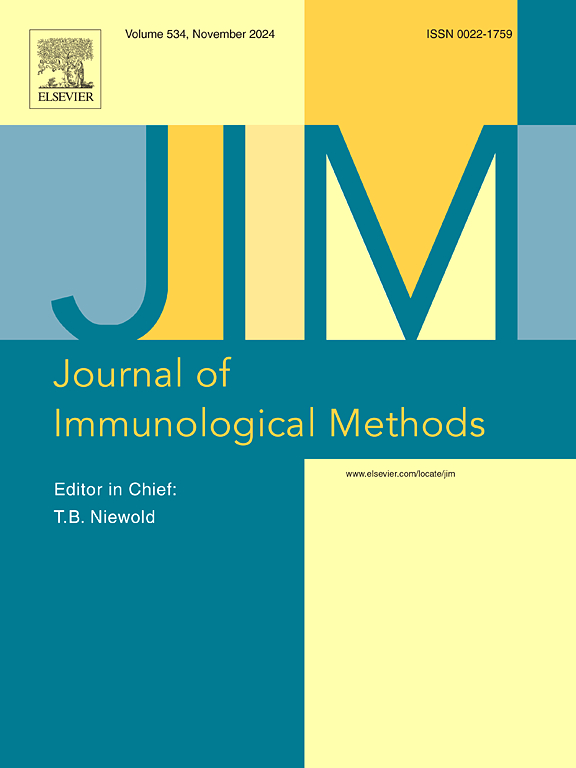High-yield production of recombinant human myelin oligodendrocyte glycoprotein in SHuffle bacteria without a refolding step
IF 1.6
4区 医学
Q4 BIOCHEMICAL RESEARCH METHODS
引用次数: 0
Abstract
Experimental autoimmune encephalomyelitis (EAE) is a model for central nervous system (CNS) autoimmune demyelinating diseases such as multiple sclerosis (MS) and MOG antibody-associated disease (MOGAD). Immunization with the extracellular domain of recombinant human MOG (rhMOG), which contains pathogenic antibody and T cell epitopes, induces B cell-dependent EAE for studies in mice. However, these studies have been hampered by rhMOG availability due to its insolubility when overexpressed in bacterial cells, and the requirement for inefficient denaturation and refolding. Here, we describe a new protocol for the high-yield production of soluble rhMOG in SHuffle cells, a commercially available E. coli strain engineered to facilitate disulfide bond formation in the cytoplasm. SHuffle cells can produce a soluble fraction of rhMOG yielding >100 mg/L. Analytical size exclusion chromatography multi-angle light scattering (SEC-MALS) and differential scanning fluorimetry of purified rhMOG reveals a homogeneous monomer with a high melting temperature, indicative of a well-folded protein. An in vitro proliferation assay establishes that purified rhMOG can be processed and recognized by T cells expressing a T cell receptor (TCR) specific for the immunodominant MOG35–55 peptide epitope. Lastly, immunization of wild-type, but not B cell deficient, mice with rhMOG resulted in robust induction of EAE, indicating a B cell-dependent induction. Our SHuffle cell method greatly simplifies rhMOG production by combining the high yield and speed of bacterial cell expression with enhanced disulfide bond formation and folding, which will enable further investigation of B cell-dependent EAE and expand human research of MOG in CNS demyelinating diseases.
在 SHuffle 细菌中高产生产重组人髓鞘少突胶质细胞糖蛋白,无需再折叠步骤。
实验性自身免疫性脑脊髓炎(EAE)是中枢神经系统(CNS)自身免疫性脱髓鞘疾病(如多发性硬化症(MS)和 MOG 抗体相关疾病(MOGAD))的一种模型。重组人 MOG(rhMOG)细胞外结构域含有致病抗体和 T 细胞表位,用它进行免疫可诱导 B 细胞依赖性 EAE,用于小鼠研究。然而,由于 rhMOG 在细菌细胞中过度表达时不溶解,而且需要低效变性和重折叠,这些研究一直受到 rhMOG 可用性的阻碍。在这里,我们介绍了一种在 SHuffle 细胞中高产生产可溶性 rhMOG 的新方案。SHuffle 细胞可生产可溶性 rhMOG 部分,产量大于 100 毫克/升。分析纯化的 rhMOG 的尺寸排阻色谱多角度光散射(SEC-MALS)和差示扫描荧光测定法发现,其单体均匀,熔点高,表明蛋白质折叠良好。体外增殖试验证明,纯化的 rhMOG 可被表达特异性 T 细胞受体(TCR)的 T 细胞处理和识别,而 T 细胞受体是免疫显性 MOG35-55 多肽表位的特异性 T 细胞受体。最后,用 rhMOG 免疫野生型小鼠(而非 B 细胞缺陷型小鼠)可强效诱导 EAE,这表明诱导作用依赖于 B 细胞。我们的SHuffle细胞法结合了细菌细胞表达的高产率和速度以及增强的二硫键形成和折叠,大大简化了rhMOG的生产,这将有助于进一步研究B细胞依赖性EAE,并拓展人类对中枢神经系统脱髓鞘疾病中MOG的研究。
本文章由计算机程序翻译,如有差异,请以英文原文为准。
求助全文
约1分钟内获得全文
求助全文
来源期刊
CiteScore
4.10
自引率
0.00%
发文量
120
审稿时长
3 months
期刊介绍:
The Journal of Immunological Methods is devoted to covering techniques for: (1) Quantitating and detecting antibodies and/or antigens. (2) Purifying immunoglobulins, lymphokines and other molecules of the immune system. (3) Isolating antigens and other substances important in immunological processes. (4) Labelling antigens and antibodies. (5) Localizing antigens and/or antibodies in tissues and cells. (6) Detecting, and fractionating immunocompetent cells. (7) Assaying for cellular immunity. (8) Documenting cell-cell interactions. (9) Initiating immunity and unresponsiveness. (10) Transplanting tissues. (11) Studying items closely related to immunity such as complement, reticuloendothelial system and others. (12) Molecular techniques for studying immune cells and their receptors. (13) Imaging of the immune system. (14) Methods for production or their fragments in eukaryotic and prokaryotic cells.
In addition the journal will publish articles on novel methods for analysing the organization, structure and expression of genes for immunologically important molecules such as immunoglobulins, T cell receptors and accessory molecules involved in antigen recognition, processing and presentation. Submitted full length manuscripts should describe new methods of broad applicability to immunology and not simply the application of an established method to a particular substance - although papers describing such applications may be considered for publication as a short Technical Note. Review articles will also be published by the Journal of Immunological Methods. In general these manuscripts are by solicitation however anyone interested in submitting a review can contact the Reviews Editor and provide an outline of the proposed review.

 求助内容:
求助内容: 应助结果提醒方式:
应助结果提醒方式:


